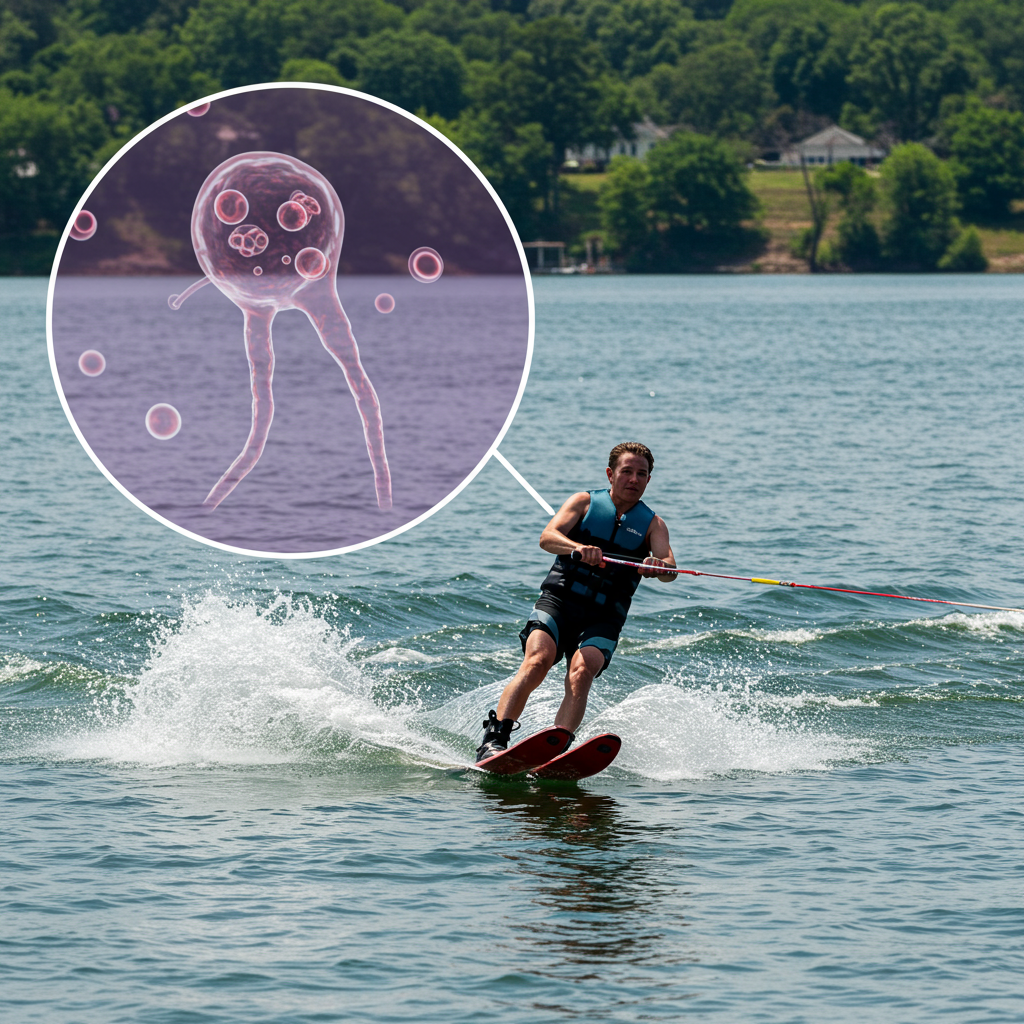A rare and serious health alert has emerged from Missouri, sparking concerns for those enjoying its beloved waterways. A resident has been hospitalized with a confirmed case of a “brain-eating amoeba” infection, specifically Primary Amebic Meningoencephalitis (PAM). This severe illness is caused by Naegleria fowleri, a microscopic organism. While investigations continue, preliminary findings suggest the patient may have contracted the infection after water skiing at the popular Lake of the Ozarks. This incident serves as a crucial reminder for freshwater enthusiasts to understand the risks and adopt simple safety measures.
Understanding Naegleria fowleri and PAM
The mention of a “brain-eating amoeba” understandably causes alarm. However, understanding this organism and the disease it causes is key to informed prevention rather than panic.
What is Naegleria fowleri?
Naegleria fowleri is a single-celled amoeba, a type of protozoa. It is naturally found in warm freshwater bodies across the globe. This includes lakes, rivers, ponds, and even hot springs. The amoeba thrives in warmer temperatures, typically above 77°F (25°C), making late summer months (July, August, September) a peak time for its proliferation. It is also present in soil. Importantly, Naegleria fowleri is not found in saltwater or properly chlorinated swimming pools.
What is Primary Amebic Meningoencephalitis (PAM)?
PAM is the severe and almost universally fatal brain infection caused by Naegleria fowleri. When water containing the amoeba enters a person’s nose, the amoeba can travel up to the brain. Once there, it begins to destroy brain tissue, leading to rapid swelling and the devastating symptoms of meningitis. This destructive action is why it’s commonly referred to as a “brain-eating” amoeba. Despite its terrifying nickname, it’s critical to remember that PAM cannot be contracted by swallowing water or through person-to-person contact.
The Missouri Case: Lake of the Ozarks Connection
Missouri health officials confirmed the recent PAM case. The patient, an adult resident, is currently receiving intensive care in a St. Louis hospital. This marks a concerning, yet extremely rare, incident for the state. While the precise source of infection is still under active investigation by the Missouri Department of Health and Senior Services (DHSS), initial information indicates the patient had been water skiing in the Lake of the Ozarks days before becoming ill.
The Lake of the Ozarks is a vast and popular recreational destination in central Missouri. It draws millions of visitors annually for boating, swimming, and water sports. The DHSS emphasizes that this is the only suspected case currently being investigated in Missouri. Past cases in the state are exceedingly rare, with records showing only two previous instances: one in 1987 and another in 2022.
How Infections Occur (and Don’t)
The unique mode of transmission for Naegleria fowleri is crucial to grasp. Infection happens only when water containing the amoeba is forcefully pushed up the nose. This often occurs during activities like:
Diving or jumping into freshwater.
Swimming in warm, stagnant water.
Water skiing or wakeboarding.
Playing in shallow, disturbed sediment at the bottom of lakes or rivers.
The amoeba then travels from the nasal passages to the brain. It is vital to reiterate that:
Swallowing water does NOT cause infection. The amoeba is destroyed by stomach acid.
Infection is NOT spread from person to person.
It is NOT contracted from properly treated tap water or chlorinated pools. However, poorly maintained or untreated pools and splash pads can pose a risk.
It remains largely unknown why some individuals contract this infection while others engaging in the same activities do not.
Recognizing Symptoms: When to Seek Immediate Help
The early symptoms of PAM can be non-specific, often mimicking bacterial meningitis. They typically appear within 1 to 12 days after exposure, with an average onset around five days.
Initial Symptoms (typically 1-7 days after infection):
Severe frontal headache
Fever
Nausea
Vomiting
Progressive Symptoms (as the disease worsens):
Stiff neck
Confusion
Disorientation
Lack of attention to surroundings
Balance problems
Seizures
Hallucinations
Coma
Given the extremely high fatality rate of PAM (over 97%), rapid diagnosis and treatment are critical. If you or someone you know experiences any of these symptoms, especially after recent swimming or water activities in warm freshwater, seek immediate medical attention. Inform your healthcare provider about your recent water exposure.
Essential Prevention Strategies for Warm Freshwater
Despite the severity, PAM infections are incredibly rare. Public health authorities, including the Centers for Disease Control and Prevention (CDC), advise focusing on sensible precautions rather than avoiding freshwater recreation entirely.
Nose Protection
The primary way to prevent infection is to keep water from entering your nose in risky environments.
Hold your nose: Simply pinch your nose shut when jumping, diving, or putting your head underwater.
Use nose clips: These are an effective barrier for water sports and swimming.
Keep your head above water: Especially when in hot springs or if you’re concerned about water quality.
Avoiding Sediment
Naegleria fowleri often resides in the sediment at the bottom of freshwater bodies.
Avoid stirring up the bottom: Refrain from digging, kicking up mud, or disturbing sediment in shallow, warm freshwater.
Enter water gently: Avoid forceful entries that can churn up the bottom.
Safe Water for Nasal Rinsing
If you use a neti pot or other device for rinsing your sinuses or nasal passages, always use distilled, sterile, or previously boiled and cooled tap water. Never use untreated tap water for this purpose, as it could contain harmful organisms, including Naegleria fowleri.
Rarity vs. Risk: Understanding the Statistics
The extreme rarity of PAM cannot be overstated. Between 1962 and 2024, only 167 cases have been reported in the entire United States. On average, fewer than 10 cases occur nationwide each year. This is compared to the millions of people who safely enjoy swimming and water sports in freshwater environments annually.
While the outcome of infection is almost always fatal (death typically occurs within 1 to 18 days, averaging five days after symptoms begin), the chances of encountering Naegleria fowleri and subsequently developing PAM are infinitesimally small. Health officials do not recommend closing public freshwater bodies, but rather educating the public on specific risk reduction behaviors.
Potential Treatments for PAM
Treatment for PAM is challenging due to its rapid progression and high fatality rate. There is currently no definitive, highly effective treatment. Medical efforts typically involve a combination of antifungal medications and antibiotics. These may include rifampin, azithromycin, and the antifungal drug miltefosine. Miltefosine has shown some promise in laboratory settings and has been used in a few surviving patients. However, the overall efficacy of these drugs in actual infected individuals remains largely unknown given the rarity of survivors. Early diagnosis is paramount, though often difficult, for any chance of successful intervention.
Prioritizing Your Safety in Warm Waters
The Missouri case serves as a sober reminder of the unseen risks that can exist in nature. While the likelihood of Naegleria fowleri infection is exceptionally low, the consequences are severe. By understanding how the amoeba operates and adopting simple, practical precautions like using nose clips or holding your nose when submerged, you can significantly reduce your risk while continuing to enjoy the vast recreational opportunities our warm freshwater bodies offer. Stay informed, stay vigilant, and prioritize your health.
Frequently Asked Questions
What is Naegleria fowleri and how rare is infection?
Naegleria fowleri is a microscopic, single-celled amoeba found naturally in warm freshwater bodies like lakes and rivers. It causes a rare, severe, and almost always fatal brain infection called Primary Amebic Meningoencephalitis (PAM). Despite its presence in many freshwater environments, human infection is exceedingly rare. Historically, between 1962 and 2024, only 167 cases have been reported across the entire United States, averaging fewer than 10 cases per year. This highlights its extreme rarity compared to the millions who safely enjoy water activities.
Where is Naegleria fowleri typically found, and what precautions should I take at places like Lake of the Ozarks?
Naegleria fowleri thrives in warm freshwater, particularly when water temperatures exceed 77°F (25°C). This includes lakes, rivers, ponds, and hot springs, making popular recreational spots like the Lake of the Ozarks potential habitats. To reduce your risk of infection while swimming or engaging in water sports, hold your nose closed, use nose clips, or keep your head above water. Also, avoid stirring up sediment at the bottom of lakes or rivers, as the amoeba often resides in these disturbed areas.
When should I seek medical attention if I suspect a Naegleria fowleri infection?
You should seek immediate medical attention if you experience symptoms such as a severe headache, high fever, nausea, vomiting, stiff neck, confusion, or seizures, especially if these symptoms appear within 1 to 12 days after swimming or engaging in other water activities in warm freshwater. Inform your healthcare provider about your recent water exposure. Early diagnosis is critical for any chance of effective treatment, although the fatality rate for PAM remains very high.




